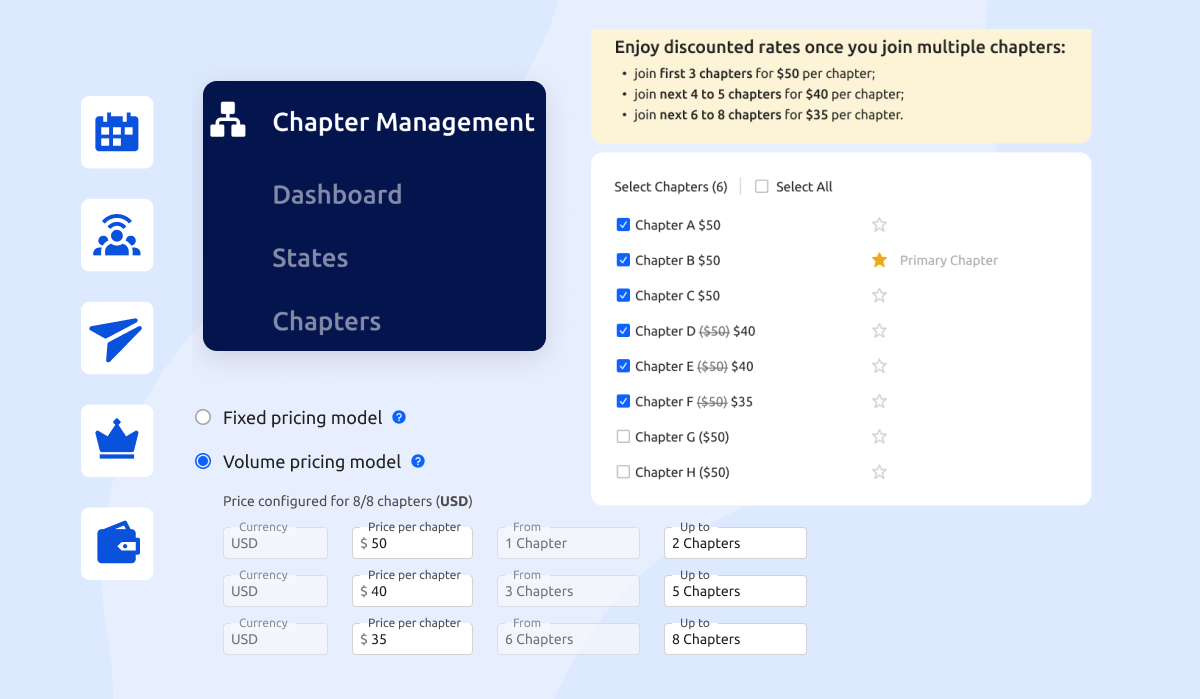
Disconnected chapters are like gears that don’t align; no matter how fast you spin them, they won’t drive the machine forward. Misaligned chapter goals cause friction, create inefficiencies, and lead to missed opportunities, which slow down organizational progress and reduce impact. To achieve long-term success, you must align chapter goals with the overall organizational strategy.
This blog will provide actionable steps to help your chapters seamlessly collaborate as they address their unique needs and priorities.
Why Alignment Matters

Before proceeding to the steps or procedure, let’s quickly understand why it’s essential for chapters to align with the overall organizational goals. Misalignment can create duplicate efforts, inconsistent member experiences, and inefficient resource use, ultimately hindering growth.
Chapters may pursue conflicting priorities without proper alignment, which can pull the organization in different directions and reduce its overall impact.
When chapters collaborate with the organizational strategy, they contribute to a unified mission. Highly aligned companies grow revenue 58% faster, are 72% more profitable, and retain customers 2.23 to 1. Thus, alignment is clearly essential for long-term success.
This alignment guarantees consistent messaging, optimized resource allocation, and improved collaboration. It also allows accurate performance measurement, as everyone is working toward the same objectives. In short, alignment builds cohesion, where each chapter becomes a driving force for collective success.
Steps to Align Chapter Goals
1. Define Clear Organizational Objectives
For example, suppose your organization’s primary goal is to increase overall membership by 20% in the next year. In that case, you can assign each chapter regional targets based on its capacity and past performance, such as hosting quarterly recruitment events or offering member-exclusive benefits.
2. Communicate Expectations Across All Chapters
Hold regular meetings or workshops to discuss organizational goals and explain how chapters can align their activities. Maintain open communication channels for feedback so that chapters feel engaged and motivated to work toward common goals.
3. Customize Goals Based on Chapter Needs
Overall alignment is critical, but recognize that each chapter may have unique challenges and opportunities. Customize goals to reflect local priorities without deviating from the organization’s core strategy.
For instance, a chapter in a rural area may focus on providing resources to small businesses, while an urban chapter could prioritize networking events for large corporations. Both objectives support the organization’s mission but cater to different member needs.
4. Create a Collaborative Planning Process
You need to develop strategic plans in collaboration with chapter leaders. This promotes collective ownership and keeps individual chapter plans aligned with the organizational strategy.
5. Monitor Progress and Provide Feedback

Set key performance indicators (KPIs) for chapters and regularly review their progress. Offer constructive feedback to help them stay on track and address any challenges they face.
6. Recognize and Reward Achievements
You must celebrate chapters that achieve their goals and contribute significantly to the organization’s success. Recognition inspires motivation and encourages continuous improvement.
Following these steps will help your chapters work cohesively, contribute to the organization's overall success, and meet their localized needs.
The Advantages of Aligning Chapter Goals
The level of strategic alignment within an organization explains up to 80% of the difference in performance between organizations. Here’s what you can expect when alignment is achieved:
1. Improved Resource Efficiency
Aligned chapters prevent duplicated efforts and resource wastage. Working toward common objectives allows your chapters to share tools, insights, and strategies that save time and money.
2. Consistent Member Experiences
Members across different regions or chapters receive the same high-quality experience. Consistent programs, services, and communications build trust and satisfaction, leading to stronger member retention.
3. Better Performance Tracking
Alignment enables performance tracking at both the chapter and organizational levels using shared metrics and key performance indicators (KPIs). This helps you identify areas of improvement and growth opportunities quickly.
4. Enhanced Collaboration
Chapters working toward the same mission promote collaboration rather than competition. Teams share successes and solutions to boost overall productivity and problem-solving capabilities.
5. Increased Organizational Impact
When chapters contribute to the same strategic goals, their combined efforts amplify the organization’s overall impact, i.e., increasing memberships or expanding programs; unified efforts yield stronger results
Aligning chapter goals is more than just a strategy; it drives consistent performance, resource optimization, and meaningful results across the organization.
Mistakes to Avoid for Effective Alignment
1. Neglecting Clear Communication
2. Overlooking Chapter-Specific Needs
3. Relying on Short-Term Focus
4. Ignoring Performance Tracking
5. Overloading Chapters With Unrealistic Expectations
6. Dismissing Member Feedback
Achieving Chapter Alignment Through Glue Up

Glue Up’s Chapter Management Software provides powerful features to help align chapter goals with your organization’s overall strategy. It promotes collaboration, efficient goal tracking, and consistent member experiences.
Let’s explore the essential features that drive alignment:
1. Unified Dashboard and Data Aggregation
The centralized dashboard consolidates data from all chapters and provides a comprehensive view of membership, events, and financial performance. This unified approach allows you to monitor chapter progress toward organizational goals, keeping everything aligned.
2. Consistent Membership Processes
The software standardizes membership workflows across chapters, maintaining uniformity in data collection, renewals, and application processes. This consistency helps your chapters contribute to shared membership targets while retaining local flexibility.
3. Shared Event Calendar and Consolidated Data
The shared event calendar provides visibility across all chapters, eliminating duplicated efforts and encouraging collaboration. Event data flows directly to the central dashboard, and it is easy to evaluate how chapter events contribute to the organization’s success.
4. Customizable Communication Templates for Brand Uniformity
Glue Up’s customizable templates help maintain unified communication and branding across chapters. This uniformity supports member engagement while keeping messaging aligned with organizational goals.
5. Task Management and Workflow Automation
Automated workflows and task management tools streamline operational processes, freeing up time for chapters to focus on strategic objectives. These features boost efficiency and keep chapters working within the organization’s plans.
6. In-depth Analytics and Reporting
Real-time analytics and performance reports help you track progress and understand how each chapter is performing against its objectives. Data-driven insights support timely adjustments and improved goal alignment.
7. Chapter-Specific Flexibility Within a Unified Framework
Although Glue Up promotes unified processes, it also allows chapters to customize workflows and events to meet their unique needs without losing sight of the larger organizational mission.
Glue Up empowers you to align chapter goals with organizational objectives effortlessly, leading to better collaboration, efficient resource use, and long-term growth. Ready to see how it works? Book a demo and discover the benefits firsthand.



